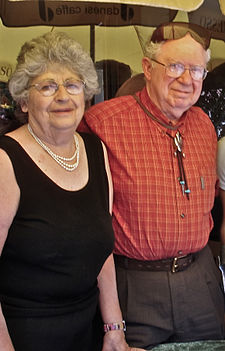Thelma Estrin
| Thelma Estrin | |
|---|---|

Thelma Estrin with her husband Gerald. Santa Monica, California. Sept. 2007
|
|
| Born |
21 February 1924 New York City, United States |
| Died | 15 February 2014 (aged 89) Santa Monica, California |
| Fields | Computer Science |
| Institutions |
Columbia Presbyterian Hospital Los Angeles Valley College Weizmann Institute of Science UCLA |
| Alma mater | University of Wisconsin–Madison |
| Thesis | Determination of the capacitance of annular-plate capacitors by the method of subareas (1951) |
| Doctoral advisor | Thomas J. Higgins |
| Notable awards | IEEE Haraden Pratt Award |
Thelma Estrin (February 21, 1924 – February 15, 2014) was an American computer scientist and engineer who did pioneering work in the fields of expert systems and biomedical engineering. She was one of the first to apply computer technology to healthcare and medical research. She was Professor Emerita in the Department of Computer Science, University of California at Los Angeles,
Thelma Austern was born in New York City and attended public schools there. Demonstrating an early aptitude for mathematics, she began her higher education at City College of New York, initially planning to become an accountant. At City College she met Gerald Estrin in 1941; they were married when she was seventeen. When Gerald Estrin entered the Army during World War II, Thelma took a three-month engineering assistant course at Stevens Institute of Technology in 1942, and soon after she then began working at Radio Receptor Company building electronic devices where she developed an interest in engineering.
She began to develop an interest in engineering while working at Radio Receptor Company. After the war, Thelma and Gerald Estrin both entered the University of Wisconsin-Madison, where they both earned degrees in Electrical Engineering. Thelma received her BSc in 1948, her MSc in 1949, and her PhD in 1951.
They moved to Princeton, New Jersey, in the early 1950s, where Gerald joined the Institute for Advanced Study at Princeton and became associated with the group that formed around John von Neumann. Thelma obtained a research position in the Electroencephalograph Department of the Neurological Institute of New York at Columbia Presbyterian Hospital in New York City, where she developed an interest in biomedical engineering.
...
Wikipedia
